Armored Core is a third-person shooter mecha video game series developed by FromSoftware. The series centers on a silent protagonist who takes on work as a mercenary pilot in the far future, operating large robot combat units known as Armored Cores at the behest of corporate and private clients. As the player completes missions for these clients, they gain credits to improve their Armored Core and unlock further opportunities to make money. Some games include an "Arena" mode in which the player fights other Armored Core pilots in head-to-head battles, which can reward the player with further income or prestige.
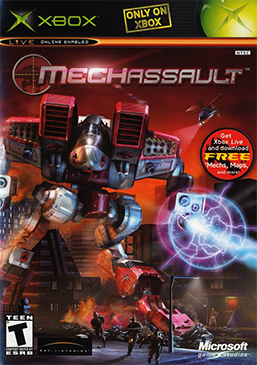
MechAssault is a video game released for the Xbox notable for being one of the first games to support Xbox Live online multiplayer. Developed by Day 1 Studios and published by Microsoft, MechAssault was initiated when Denny Thorley of Day 1 Studios approached Jon Kimmich of Microsoft about developing an original BattleTech game built from the ground up to support console play. "MechAssault" was released in November 2002. A sequel, MechAssault 2: Lone Wolf, was released on December 28, 2004. Both games are set in the BattleTech fictional universe.

Chromehounds is a 2006 mech simulator video game developed by FromSoftware and published by Sega for the Xbox 360. The game is set in an alternate universe where mecha known as HOUNDs battle for control of Neroimus, a fictional region near the Black Sea. Chromehounds features a system for personalized customization of the player's mecha and an online campaign mode where players wage war in a persistent world over Xbox Live. The game's online servers were shut down in January 2010.

Armored Core is a 1997 third-person shooter mecha video game developed by FromSoftware and published by Sony Computer Entertainment for the PlayStation. It was originally released in Japan by FromSoftware in July 1997 and in North America in October 1997 and Europe in 1998 by Sony Computer Entertainment. The game is the first entry in the Armored Core series. A digital port was released in 2007 in Japan and 2015 in North America on the PlayStation Network as a part of the PSone Classics line of games.
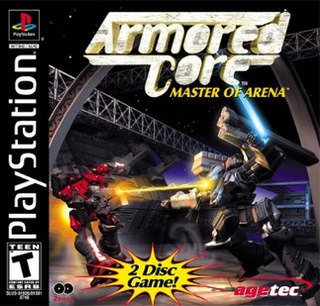
Armored Core: Master of Arena is a 1999 third-person shooter mecha video game developed by FromSoftware for the PlayStation. Master of Arena is the third entry in the Armored Core series and a direct sequel to Armored Core: Project Phantasma. It is the final game in the original Armored Core trilogy. The game was not released in Europe. An indirect sequel, Armored Core 2, was released on August 3, 2000, for the PlayStation 2.

Armored Core 2 is a 2000 third-person shooter mecha video game developed by FromSoftware for the PlayStation 2. It is the fourth entry in the Armored Core series and an indirect sequel to Armored Core: Master of Arena. In North America, Armored Core 2 was a launch title for the PlayStation 2. A direct sequel, Armored Core 2: Another Age, was released in 2001 for the PlayStation 2.
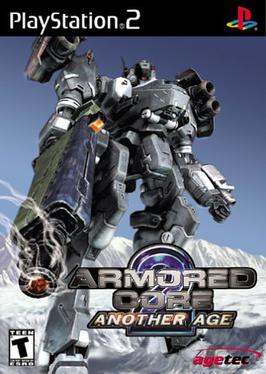
Armored Core 2: Another Age is a 2001 third-person shooter mecha video game developed by FromSoftware for the PlayStation 2. It is the fifth entry in the Armored Core series and a direct sequel to Armored Core 2. A reboot of the series, Armored Core 3, was released in 2002 for the PlayStation 2.

Armored Core 3 is a 2002 third-person shooter mecha video game developed by FromSoftware for the PlayStation 2. It is the sixth entry in the Armored Core series. Armored Core 3 acts as a reboot for the franchise and begins a storyline that would continue through Armored Core: Last Raven. In 2009, Armored Core 3 was ported to the PlayStation Portable.

Silent Line: Armored Core, known in Japan as Armored Core 3: Silent Line, is a 2003 third-person shooter mecha video game developed by FromSoftware for the PlayStation 2. It is the seventh entry in the Armored Core series and a direct sequel to 2002's Armored Core 3. In 2009, Silent Line: Armored Core was ported to the PlayStation Portable.

Armored Core: Nexus is a 2004 third-person shooter mecha video game developed by FromSoftware for the PlayStation 2. It is the eighth entry in the Armored Core series and a sequel to 2003's Silent Line: Armored Core. Unlike Silent Line, Nexus is not an expansion but rather a full-fledged sequel.

MechAssault 2: Lone Wolf is a 2004 video game developed by Day 1 Studios and published by Microsoft Game Studios exclusively for the Xbox console, and set in the BattleTech universe. Development of MechAssault 2 was announced shortly following the release of MechAssault, with the developers focusing on the expansion of online and networking features to capitalise upon the success of the original game as a pilot title for the Xbox Live online service, and creating a more open-ended gameplay style in which players are able to exit their mech and occupy multiple vehicles.

Virtua Tennis 3, known in Japan as Sega Professional Tennis: Power Smash 3, is the second arcade game sequel to Sega's tennis game franchise, Virtua Tennis. The arcade version of Virtua Tennis 3 is powered by the PC-based Sega Lindbergh arcade system board. Ports for the PC, Xbox 360, PlayStation Portable and PlayStation 3 consoles are also available with a traditional collection of tennis minigames that the home versions of Virtua Tennis are known for. In 2009, Sega updated and re-created Virtua Tennis 3 in Virtua Tennis 2009.

Metal Wolf Chaos is a third-person shooter video game developed by FromSoftware. It originally released in 2004 in Japan for the Xbox. The player takes on the role of fictional United States President Michael Wilson piloting a mech to battle the rebelling military, led by fictional Vice President Richard Hawk. Wilson's mech can be equipped with up to eight weapons selected from a set of over a hundred. In each mission, the player battles through destructible environments, destroying all enemies they come across.
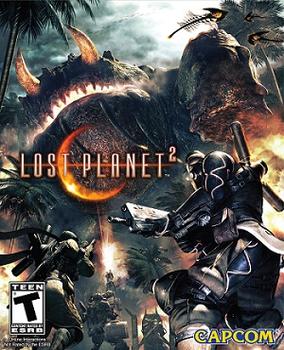
Lost Planet 2 is a third-person shooter video game developed and published by Capcom and Beeline Interactive, Inc. The game is the sequel to Lost Planet: Extreme Condition, taking place ten years after the events of the first game, on the same planet. The game was developed for BlackBerry, PlayStation 3, Xbox 360 and Microsoft Windows. Originally set to be released in early 2010, Capcom delayed the game's consoles release to May 11, 2010 in North America and Europe, May 13 in Australia and May 20 for Japan, while the BlackBerry version was released worldwide on April 28 and the Microsoft Windows version was released in October that year. The title sold more than 1.5 million copies worldwide.

Armored Core: For Answer is a 2008 mecha-based vehicular combat game developed by FromSoftware and and published by Ubisoft for the PlayStation 3 and Xbox 360. It is the 13th installment in the mecha-based Armored Core series, the game is the direct sequel to Armored Core 4.

Tiger Woods PGA Tour 09 is a sports video game developed by EA Tiburon for the PlayStation 3, Wii and Xbox 360 versions and Exient Entertainment for the PlayStation 2 and PlayStation Portable versions and published by EA Sports for PlayStation 2, PlayStation 3, PlayStation Portable, Wii and Xbox 360.

Army of Two: The 40th Day is a third-person shooter video game developed by EA Montreal and published by Electronic Arts for PlayStation 3 and Xbox 360. The game was also released for PlayStation Portable, which was developed by Buzz Monkey. It is the sequel to Army of Two. Army of Two: The 40th Day was released in 2010 worldwide.

Armored Core V is a mecha-based video game developed by FromSoftware and published by Namco Bandai Games for PlayStation 3 and Xbox 360. It is the 14th main installment in the Armored Core series and a return to the more traditional style of gameplay found in the original series of games.

Earth Defense Force: Insect Armageddon is a third-person shooter developed by Vicious Cycle Software, and published by D3 Publisher, for the PlayStation 3, Xbox 360 and Microsoft Windows. It is a spinoff built around the concept of "What if Americans made EDF" and has no story or setting connection to the numbered series.
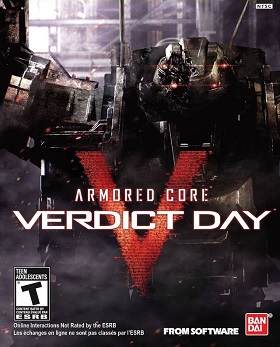
Armored Core: Verdict Day is a mech action game developed by FromSoftware and was published worldwide in September 2013 by Namco Bandai Games for PlayStation 3 and Xbox 360. It is the 15th installment in the Armored Core series and a direct sequel to Armored Core V.



















